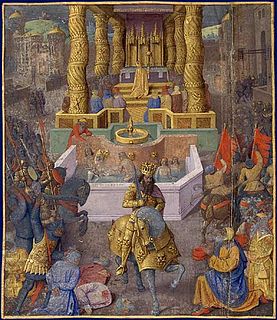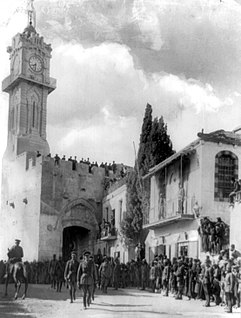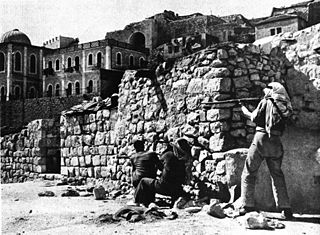 W
WHerod the Great's Siege of Jerusalem was the final step in his campaign to secure the throne of Judea. Aided by Roman forces provided by Marcus Antonius, Herod was able to capture the city and depose Antigonus II Mattathias, ending Hasmonean rule. The siege appears in the writings of Josephus and Dio Cassius.
 W
WThe Siege of Jerusalem occurred during Pompey the Great's campaigns in the East, shortly after his successful conclusion of the Third Mithridatic War. Pompey had been asked to intervene in a dispute over inheritance to the throne of the Hasmonean Kingdom, which turned into a war between Hyrcanus II and Aristobulus II. His conquest of Jerusalem, however, spelled the end of Jewish independence and the incorporation of Judea as a client kingdom of the Roman Republic.
 W
WThe Siege of Jerusalem in the year 70 CE was the decisive event of the First Jewish–Roman War, in which the Roman army captured the city of Jerusalem and destroyed both the city and its Temple. The Roman army, led by the future Emperor Titus, with Tiberius Julius Alexander as his second-in-command, besieged and conquered the city of Jerusalem, which had been controlled by Judean rebel factions since 66 CE, following the Jerusalem riots of 66, when the Judean provisional government was formed in Jerusalem.
 W
WIn 589 BC, Nebuchadnezzar II laid siege to Jerusalem, culminating in the destruction of the city and its temple in the summer of 587 or 586 BC.
 W
WThe Siege of Jerusalem was a military campaign carried out by Nebuchadnezzar II, king of Babylon, in 597 BC. In 605 BC, he defeated Pharaoh Necho at the Battle of Carchemish, and subsequently invaded Judah. According to the Nebuchadnezzar Chronicle, King Jehoiakim of Judah rebelled against Babylonian rule, but Nebuchadnezzar captured the city and installed Zedekiah as ruler.
 W
WThe Siege of Jerusalem was part of a military conflict which took place in the year 636-637/38 between the Byzantine Empire and the Rashidun Caliphate. It began when the Rashidun army, under the command of Abu Ubaidah, besieged Jerusalem beginning in November 636. After six months, the Patriarch Sophronius agreed to surrender, on condition that he submit only to the Caliph. In 637 or 638, Caliph Umar traveled to Jerusalem in person to receive the submission of the city. The Patriarch thus surrendered to him.
 W
WThe Siege of Jerusalem took place from June 7 to July 15, 1099, during the First Crusade. The climax of the First Crusade, the successful siege saw the Crusaders take Jerusalem from the Fatimid Caliphate and laid the foundations for the Kingdom of Jerusalem. The siege is notable for the mass slaughter of Muslims and Jews perpetrated by the Christian crusaders, which contemporaneous sources suggest was savage and widespread.
 W
WThe Siege of Jerusalem was a siege on the city of Jerusalem that lasted from September 20 to October 2, 1187, when Balian of Ibelin surrendered the city to Saladin. Though Jerusalem fell, it was not the end of the Kingdom of Jerusalem, as the capital shifted first to Tyre and later to Acre after the Third Crusade. Latin Christians responded in 1189 by launching the Third Crusade led by Richard the Lionheart, Philip Augustus, and Frederick Barbarossa separately.
 W
WThe 1244 Siege of Jerusalem took place after the Sixth Crusade, when roaming Khwarazmians clans conquered the city on July 15, 1244.
 W
WThe 1834 Siege of Jerusalem took place during the Peasants' revolt in Palestine, which erupted following the entry of Egyptian general Ibrahim Pasha into Ottoman Syria and his subsequent military conscription demand upon the Arab villagers of the region. The siege was engaged by local Arab peasant rebels upon an Egyptian garrison of about 2,000 soldiers, beginning from May 21 until the arrival of Ibrahim Pasha's main force on June 7. The crushing defeat of rebel reinforcements took place on June 9, led by Ibrahim Pasha.
 W
WIn approximately 701 BCE, Sennacherib, king of Assyria, attacked the fortified cities of the Kingdom of Judah in a campaign of subjugation. Sennacherib besieged Jerusalem, but failed to capture it — it is the only city mentioned as being besieged on Sennacherib's Stele, of which the capture is not mentioned.
 W
WThe Battle of Jerusalem occurred during the British Empire's "Jerusalem Operations" against the Ottoman Empire, in World War I, when fighting for the city developed from 17 November, continuing after the surrender until 30 December 1917, to secure the final objective of the Southern Palestine Offensive during the Sinai and Palestine Campaign of World War I. Before Jerusalem could be secured, two battles were recognised by the British as being fought in the Judean Hills to the north and east of the Hebron–Junction Station line. These were the Battle of Nebi Samwill from 17 to 24 November and the Defence of Jerusalem from 26 to 30 December 1917. They also recognised within these Jerusalem Operations, the successful second attempt on 21 and 22 December 1917 to advance across the Nahr el Auja, as the Battle of Jaffa, although Jaffa had been occupied as a consequence of the Battle of Mughar Ridge on 16 November.
 W
WThe Battle for Jerusalem occurred from December 1947 to 18 July 1948, during the 1947–48 Civil War in Mandatory Palestine. The Jewish and Arab populations of Mandatory Palestine and later the Israeli and Jordanian armies fought for control of Jerusalem.
 W
WBurma Road in Israel was a makeshift bypass road between Kibbutz Hulda and Jerusalem, built under the supervision of General Mickey Marcus during the 1948 Siege of Jerusalem. It was named for the Chinese Burma Road.
 W
WThe Sasanian Empire conquered Jerusalem after a brief siege in 614, during the Byzantine–Sasanian War of 602–628, after the Persian Shah Khosrau II appointed his general Shahrbaraz to conquer the Byzantine controlled areas of the Near East. Following the victory in Antioch, Shahrbaraz conquered Caesarea Maritima, the administrative capital of the province. By this time the grand inner harbor had silted up and was useless, however the Emperor Anastasius had reconstructed the outer harbor and Caesarea remained an important maritime city, providing the Persian Empire with access to the Mediterranean Sea. The Sasanian Persians were joined by Nehemiah ben Hushiel and Benjamin of Tiberias, who enlisted and armed Jewish soldiers from Tiberias, Nazareth and the mountain cities of Galilee, and together with a band of Arabs and additional Jews from southern parts of the country they marched on Jerusalem. Some 20,000 Jewish rebels joined the war against the Byzantine Christians. Depending on the chronicler figures of either 20,000 or 26,000 are given. The Persian army reinforced by Jewish forces led by Nehemiah ben Hushiel and Benjamin of Tiberias would capture Jerusalem–without resistance, or after a siege and breaching the wall with artillery, depending on the source.
 W
WThe Siege of Jebus is a siege described in biblical passages as having occurred when Israelites under King David of Israel besieged and conquered the Canaanite city of Jerusalem, then known as Jebus. The Israelites gained access by a surprise assault, making Jebus the capital of Israel under the new name, City of David.